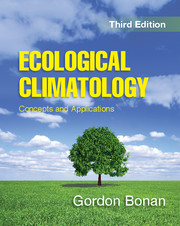Book contents
- Frontmatter
- Dedication
- Contents
- Preface
- 1 Ecosystems and Climate
- Part I The Earth System
- Part II Global Physical Climatology
- 4 Atmospheric Radiation
- 5 Atmospheric General Circulation and Climate
- 6 Earth's Climates
- 7 Climate Variability
- 8 Climate Change
- Part III Hydrometeorology
- Part IV Biometeorology
- Part V Terrestrial Plant Ecology
- Part VI Terrestrial Forcings and Feedbacks
- Appendix
- Index
- Plate section
- References
6 - Earth's Climates
from Part II - Global Physical Climatology
Published online by Cambridge University Press: 05 November 2015
- Frontmatter
- Dedication
- Contents
- Preface
- 1 Ecosystems and Climate
- Part I The Earth System
- Part II Global Physical Climatology
- 4 Atmospheric Radiation
- 5 Atmospheric General Circulation and Climate
- 6 Earth's Climates
- 7 Climate Variability
- 8 Climate Change
- Part III Hydrometeorology
- Part IV Biometeorology
- Part V Terrestrial Plant Ecology
- Part VI Terrestrial Forcings and Feedbacks
- Appendix
- Index
- Plate section
- References
Summary
Chapter Summary
This chapter gives an overview of the various climates found on Earth at the macroscale, mesoscale, and microscale. Macroclimate is the large-scale climate over 2000 km or more resulting from geographic variation in net radiation, the resultant transport of heat by the atmosphere and oceans, and high and low surface pressure belts. Temperature and precipitation distinguish various macroclimate zones. One classification scheme is that of Köppen, which illustrates the major climate zones. Mesoclimates and microclimates are regional and local climates, respectively. Microclimates are climatic features typically smaller than 2 km. A forest has a different microclimate than an adjacent clearing. Mesoscale is between microscale and macroscale, covering atmospheric processes at scales of 2–2000 km. Regional (mesoscale) climates are illustrated in terms of the effect of topography on solar radiation, temperature, and precipitation in mountains. Lakes and oceans also influence regional climate, with generally mild temperatures and reduced temperature variability compared with inland climates. Differential heating between land and ocean results in a local circulation known as a sea breeze.
Global Climate Zones
Although no two places experience exactly the same climate, several generalized climate zones can be recognized. Figure 2.1 illustrates one such climate classification – the Köppen classification as modified by Trewartha (Finch et al. 1957; Trewartha 1968). This scheme utilizes five major climate zones based on temperature and precipitation.
Humid tropical climate: warm year-round; coldest month 18°C or warmer.
Dry climate: deficient precipitation throughout the year; potential evapotranspiration exceeds precipitation.
Moist subtropical mid-latitude climate: warm to hot summers with mild winters; coldest month above –3°C but below 18°C; warmest month above 10°C.
Moist continental climate: warm summers and cold winters; coldest month below –3°C; warmest month above 10°C.
Polar climate: extremely cold winters and cold summers; warmest month below 10°C.Each of these climate zones has subzones defined by temperature and precipitation (Table 6.1).
- Type
- Chapter
- Information
- Ecological ClimatologyConcepts and Applications, pp. 89 - 102Publisher: Cambridge University PressPrint publication year: 2015



